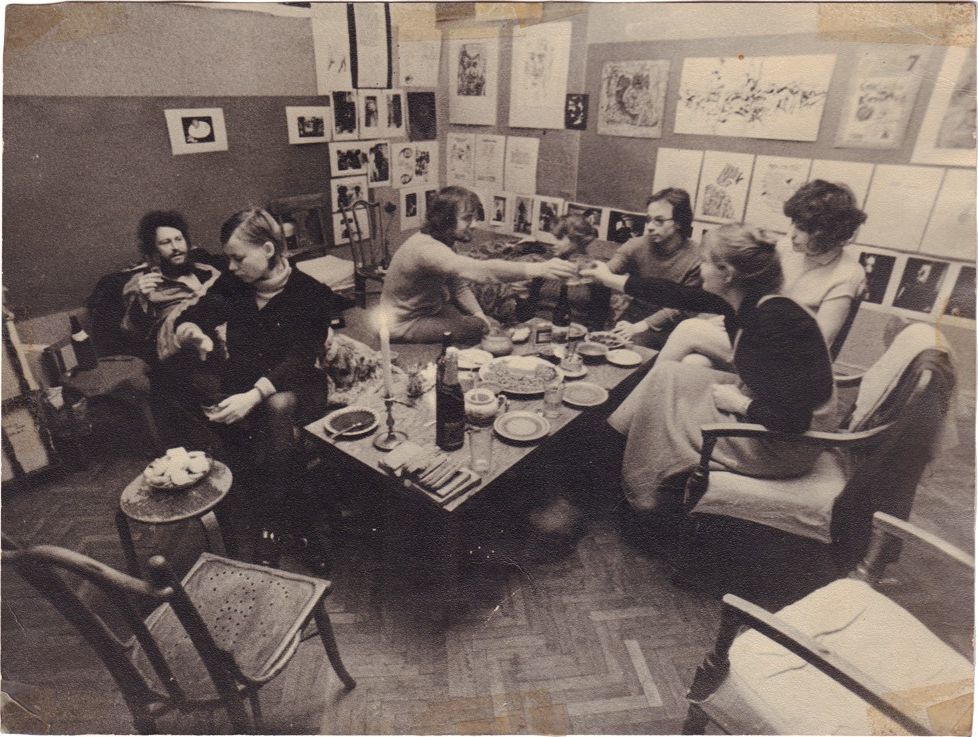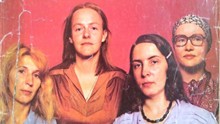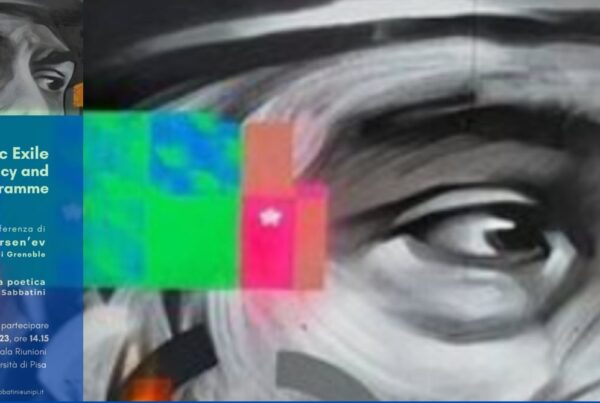
K. Kuz’minskii’s apartment, Leningrad. January 1st, 1975.
Place: Leningrad
Key: prospekt (main street); ulitsa (street); bul’var (boulevard); pereulok (alley)
Description:
After years of meeting outside, in spaces such as those adjacent to Malaia Sadovaia, in gatherings ahead of their time, such as those organised by the philologist poets, the climate of political and social reaction from the mid 1960s forced writers, artists and intellectuals to abandon extroversion and exhibitionism and retreat into the private sphere. Many of the protagonists of the “Second culture” sought privatnost’ (cf. Savitskii 2002) in the living rooms and kitchens of shared flats. There were many meaningful places in the culture of this period, several of which led to the creation of artistic or literary circles, such as Roald Mandelshtam’s room in ‘Kanonerskaia ulitsa’, where Aleksandr Aref’ev and his friends used to meet until 1961 (the year of the poet’s untimely death) and Anna Akhmatova’s house, which gave birth to the Magical Chorus (‘Volshebnyi khor’) formed by Iosif Brodskii, Dmitrii Bobyshev, Anatolii Naiman and Evgenii Rein. During the 1960s the sculptor and painter Mikhail Shemykin’s atelier in Zagorodnyi prospekt became popular until Shemykin, founder of the artistic group Peterburg and expert in poetry (cf. Sabbatini 2008: 184), emigrated in 1971 after being arrested and forcedly imprisoned several times in psikhushki (psychiatric hospitals). The house of the abstractionist Evgenii Mikhnov-Voitenko’s (ulitsa Rubinshtein, 18) also played a significant role. His house, located next to the Saigon café, was so full or artists and writers that the critic Vladimir Alfonsov commented that it was not Mikhnov “who went to the Saigon, but the Saigon who went to him” (Al’fonsov 2011). The most important and lively meeting place for the alternative Leningrad literary scene, however, was the 24 sq. metre flat where Konstantin Kuz’minskii lived. Located in Profsoiuzov (today known as Konnogvardeiskii) bul’var, it was informally known as “on the boulevard”, and welcomed dozens of poets, writers, and artists until 1975, when Kuz’minskii emigrated. Among the many regular visitors, were Krivulin, Aref’ev, Ufliand, Eremin, Bukosvkaia, Sapgir, Stratanovskii, Kushner, Gorbovskii, Sosnora, Erl, Kudriakov and Venedikt Erofeev (cf. Dolinin 2003: 24). In preparing the anthology of non-conformist verse, U goluboi laguny (At the Blue Lagoon, 1980-1986, 5 volumes), in the United States Kuz’minskii was assisted by the blind poet Grigorii Kovalev, also known as ‘Grishka the blind’ (“Grishka slepoi”), whose phenomenal aesthetic sense, capacity to memorise thousands of lines of poetry (cf. ibid.) and talent for mimicking intonation earned him the nickname “walking recorder” (“podkhodiashchii magnitofon”). Kovalev’s house at no.8 Apraksin pereulok also became a significant meeting place for Leningrad’s alternative culture (cf. Caramitti 2010: 321).
Apartment n. 37 at ulitsa Kurliandskaia 20, was the home of Lev Rudkevich and the married couple Viktor Krivulin and Tat’iana Goricheva. From 1975 the apartment became not only the venue for meetings that Krivulin dedicated to “the culture of the early century and contemporary consciousness”, but the venue for the famous religious-philosophical seminar held by Goricheva, which attracted a huge number of adherents and re-established a crucial link between the intelligentsia and the Christian-orthodox religion (cf. Parisi 2013: 158). In this apartment renowned authors like Paul Tilich, Søren Kierkegaard and Martin Heidegger, with whom Goricheva also corresponded, were read and discussed. The journal “37” was established in 1976 as “a natural extension of debates among friends” (ibid.: 160) even though during the years, and especially after Goricheva and Rudkevich were forced to emigrate in 1981, the journal changed direction, publishing essays influenced by contemporary Western thinkers and focusing on the new artistic experimentation in Moscow (cf. ibid.: 161). Among the many other private spaces active in those years, was Iulia Voznesenskaia’s room (ulitsa Zhukovskogo 19), where evenings of poetry reading were held (cf. Stratanovskii 2015: 162-ff.).
Federico Iocca
[30th June, 2021]
Translation by Diletta Bacci
Bibliography
- Al’fonsov V., Au, Mikhnov! Kniga o khudozhnike, “Zvezda” 4 (2011), https://magazines.gorky.media/zvezda/2011/4/au-mihnov-kniga-ohudozhnike, online (last accessed: 30/06/2021).
- Caramitti M., Letteratura russa contemporanea: La scrittura come resistenza, Laterza, Bari 2010.
- Dolinin V., Severiukhin D., Preodolen’e nemoty, in Dolinin V., Ivanov, B., Ostanin, B., Severiukhin, D. (eds.), Samizdat Leningrada. Literaturnaka ėntsiklopediia, Novoe Literaturnoe Obozrenie, Moskva 2003: 7-51.
- Parisi V., Il lettore eccedente. Edizioni periodiche del samizdat sovietico. 1956-1990, Il Mulino, Bologna 2013.
- Sabbatini M., “Quel che si metteva in rima”: cultura e poesia underground a Leningrado, Collana di Europa Orientalis, Salerno 2008.
- Savitskii S., Lichnoe delo: leningradskaia neofitsial’naia literatura kak privatnost’, “Slavica Tergestina”, 10 (2002): 311-330.
- Stratanovskii S., Semidesiatye – preodolenie strakha, “Enthymema”, 12 (2015): 160-165.
To cite this article:
Federico Iocca, Leningrad apartments, in Voci libere in URSS. Letteratura, pensiero, arti indipendenti in Unione Sovietica e gli echi in Occidente (1953-1991), a cura di C. Pieralli, M. Sabbatini, Firenze University Press, Firenze 2021-, <vocilibereurss.fupress.net>.
eISBN 978-88-5518-463-2
© 2021 Author(s)
Content license: CC BY 4.0




